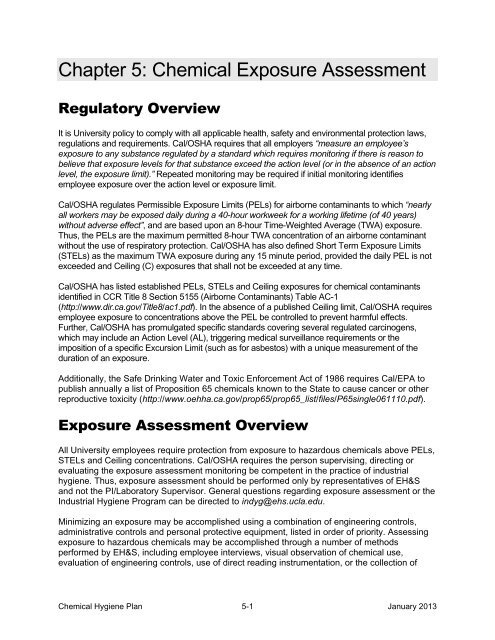Lab Safety Manual - UCLA - Environment, Health & Safety
Lab Safety Manual - UCLA - Environment, Health & Safety
Lab Safety Manual - UCLA - Environment, Health & Safety
You also want an ePaper? Increase the reach of your titles
YUMPU automatically turns print PDFs into web optimized ePapers that Google loves.
Chapter 5: Chemical Exposure Assessment<br />
Regulatory Overview<br />
It is University policy to comply with all applicable health, safety and environmental protection laws,<br />
regulations and requirements. Cal/OSHA requires that all employers “measure an employee’s<br />
exposure to any substance regulated by a standard which requires monitoring if there is reason to<br />
believe that exposure levels for that substance exceed the action level (or in the absence of an action<br />
level, the exposure limit).” Repeated monitoring may be required if initial monitoring identifies<br />
employee exposure over the action level or exposure limit.<br />
Cal/OSHA regulates Permissible Exposure Limits (PELs) for airborne contaminants to which “nearly<br />
all workers may be exposed daily during a 40-hour workweek for a working lifetime (of 40 years)<br />
without adverse effect”, and are based upon an 8-hour Time-Weighted Average (TWA) exposure.<br />
Thus, the PELs are the maximum permitted 8-hour TWA concentration of an airborne contaminant<br />
without the use of respiratory protection. Cal/OSHA has also defined Short Term Exposure Limits<br />
(STELs) as the maximum TWA exposure during any 15 minute period, provided the daily PEL is not<br />
exceeded and Ceiling (C) exposures that shall not be exceeded at any time.<br />
Cal/OSHA has listed established PELs, STELs and Ceiling exposures for chemical contaminants<br />
identified in CCR Title 8 Section 5155 (Airborne Contaminants) Table AC-1<br />
(http://www.dir.ca.gov/Title8/ac1.pdf). In the absence of a published Ceiling limit, Cal/OSHA requires<br />
employee exposure to concentrations above the PEL be controlled to prevent harmful effects.<br />
Further, Cal/OSHA has promulgated specific standards covering several regulated carcinogens,<br />
which may include an Action Level (AL), triggering medical surveillance requirements or the<br />
imposition of a specific Excursion Limit (such as for asbestos) with a unique measurement of the<br />
duration of an exposure.<br />
Additionally, the Safe Drinking Water and Toxic Enforcement Act of 1986 requires Cal/EPA to<br />
publish annually a list of Proposition 65 chemicals known to the State to cause cancer or other<br />
reproductive toxicity (http://www.oehha.ca.gov/prop65/prop65_list/files/P65single061110.pdf).<br />
Exposure Assessment Overview<br />
All University employees require protection from exposure to hazardous chemicals above PELs,<br />
STELs and Ceiling concentrations. Cal/OSHA requires the person supervising, directing or<br />
evaluating the exposure assessment monitoring be competent in the practice of industrial<br />
hygiene. Thus, exposure assessment should be performed only by representatives of EH&S<br />
and not the PI/<strong>Lab</strong>oratory Supervisor. General questions regarding exposure assessment or the<br />
Industrial Hygiene Program can be directed to indyg@ehs.ucla.edu.<br />
Minimizing an exposure may be accomplished using a combination of engineering controls,<br />
administrative controls and personal protective equipment, listed in order of priority. Assessing<br />
exposure to hazardous chemicals may be accomplished through a number of methods<br />
performed by EH&S, including employee interviews, visual observation of chemical use,<br />
evaluation of engineering controls, use of direct reading instrumentation, or the collection of<br />
Chemical Hygiene Plan 5-1 January 2013
















